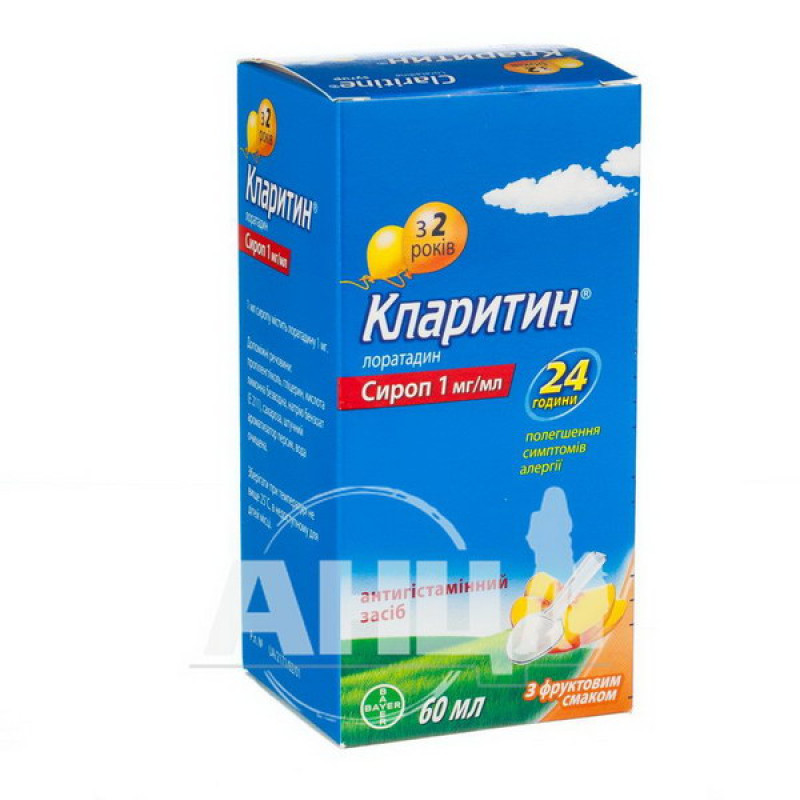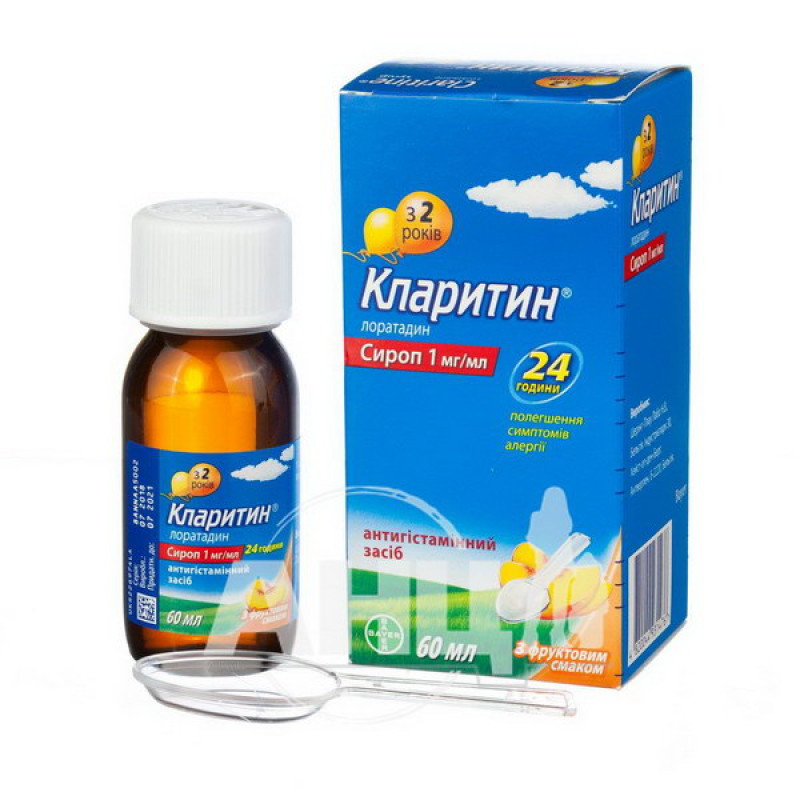Claritin syrup bottle 60 ml

Pharmacological properties
Pharmacodynamics. Loratadine (active ingredient of the drug Claritin®) is a tricyclic antihistamine with selective activity on peripheral H1 receptors.
In most patients, when using the recommended dose, loratadine does not have a clinically significant sedative and anticholinergic effect. During long-term treatment, no clinically significant changes in vital signs, laboratory tests, physical examination, or ECG were observed. Loratadine does not have a significant effect on H 2 -histamine receptors. The drug does not inhibit the uptake of norepinephrine and has virtually no effect on cardiovascular function or cardiac pacemaker activity.
Studies with histamine skin tests after taking a single dose of 10 mg have shown that the antihistamine effect occurs after 1-3 hours, reaches a peak after 8-12 hours and lasts for more than 24 hours. No development of resistance to the drug has been observed after 28 days of use of loratadine.
Clinical efficacy and safety. More than 10,000 men (aged 12 years and older) have been treated with loratadine (10 mg tablets) in controlled clinical trials. Loratadine (tablets) 10 mg once daily was more effective than placebo and as effective as clemastine in improving symptoms (nasal and non-nasal) of allergic rhinitis. In these trials, somnolence occurred less frequently with loratadine than with clemastine and was about the same as with terfenadine and placebo.
Among the participants in these studies (aged 12 years and older), 1,000 patients with chronic idiopathic urticaria were also enrolled in placebo-controlled studies. Loratadine 10 mg once daily was more effective than placebo in the treatment of chronic idiopathic urticaria, as evidenced by the reduction of pruritus, erythema, and allergic rash. In these studies, the incidence of drowsiness was similar between loratadine and placebo.
Children: Approximately 200 children (aged 6-12 years) with seasonal allergic rhinitis received loratadine (syrup) at doses up to 10 mg once daily in controlled clinical trials. In another study, 60 children (aged 2-5 years) received loratadine (syrup) at a dose of 5 mg once daily. No unexpected adverse reactions were observed.
Efficacy in children was similar to that in adults.
Pharmacokinetics. Absorption. Loratadine is rapidly and well absorbed. Taking the drug with food may slightly delay the absorption of loratadine, but this does not affect the clinical effect. The bioavailability of loratadine and its active metabolite is dose-proportional.
Distribution: Loratadine is highly bound (97 to 99%) to plasma proteins, and its active metabolite is moderately bound (73 to 76%).
In healthy volunteers, the plasma half-life of loratadine and its active metabolite is approximately 1 and 2 hours, respectively.
Biotransformation. After oral administration, loratadine is rapidly and well absorbed and extensively metabolized during the first pass through the liver, mainly by CYP 3A4 and CYP 2D6. The main metabolite, desloratadine, is pharmacologically active and is largely responsible for the clinical effect. Loratadine and desloratadine reach C max in blood plasma 1-1.5 h and 1.5-3.7 h, respectively, after administration.
Excretion. About 40% of the dose is excreted in the urine and 42% in the feces within 10 days, mainly in the form of conjugated metabolites. About 27% of the dose is excreted in the urine during the first 24 hours. Less than 1% of the active substance is excreted in unchanged active form - as loratadine or desloratadine.
In adult healthy volunteers, the mean T½ of loratadine was 8.4 h (range 3 to 20 h) and that of the main active metabolite was 28 h (range 8.8 to 92 h).
Renal impairment. In patients with chronic renal impairment, plasma AUC and Cmax of loratadine and its active metabolite were increased compared with those in patients with normal renal function. The mean T½ of loratadine and its active metabolite was not significantly different from that in healthy subjects. In patients with chronic liver impairment, hemodialysis did not affect the pharmacokinetics of loratadine and its active metabolite.
Liver function impairment. In patients with chronic alcoholic liver disease, the AUC and Cmax of loratadine were 2-fold higher, and those of its active metabolite were not significantly altered when compared with those of patients with normal liver function. The half-lives of loratadine and its active metabolite are 24 and 37 hours, respectively, and increase with the severity of liver disease.
Elderly patients: The pharmacokinetics of loratadine and its active metabolite were similar in healthy adult volunteers and healthy elderly volunteers.
Indication
Tablets: symptomatic treatment of allergic rhinitis and chronic idiopathic urticaria.
Syrup: symptomatic treatment of allergic rhinitis and chronic idiopathic urticaria in adults and children aged 2 years and over.
Application
Tablets. are used orally. Tablets can be taken regardless of meals.
In children aged 2 to 12 years, the dose depends on body weight. With a body weight of more than 30 kg: 10 mg (1 tablet) 1 time per day. In children weighing less than 30 kg, the drug should be used in the form of a syrup.
Elderly patients: No dose adjustment is required for elderly patients.
Patients with hepatic impairment. Patients with severe hepatic impairment should be given a low initial dose as they may have reduced clearance of loratadine. For adults and children weighing more than 30 kg, the recommended initial dose is 10 mg every other day.
Patients with renal impairment: No dose adjustment is necessary in patients with renal impairment.
Children. The efficacy and safety of loratadine in children under 2 years of age have not been established. Claritin® tablets should be administered to children weighing more than 30 kg.
Syrup. Administered orally. The syrup can be taken regardless of meals. Adults and children over 12 years of age take 10 ml of syrup (10 mg of loratadine) once a day.
Doses for children aged 2-12 years depend on body weight.
Children weighing more than 30 kg - 10 ml of syrup (10 mg of loratadine) once a day.
Children weighing less than 30 kg - 5 ml of syrup (5 mg of loratadine) once a day.
No dose adjustment is required for the elderly and patients with renal insufficiency. Patients with severe hepatic impairment should be given a lower initial dose due to a possible decrease in loratadine clearance (for adults and children weighing more than 30 kg, the recommended initial dose is 10 mg every other day, and for children weighing up to 30 kg - 5 mg every other day).
Patients with renal impairment: No dose adjustment is necessary in patients with renal impairment.
Children: The efficacy and safety of the drug in children under 2 years of age have not been established.
Contraindication
Hypersensitivity to the active substance or any other component of the drug.
Side effects
Summary of the safety profile. In clinical trials in adults and adolescents with loratadine at the recommended dose of 10 mg/day in indications including allergic rhinitis and chronic idiopathic urticaria, adverse reactions were reported in 2% of patients (which is higher than in patients receiving placebo). The most common adverse reactions reported more frequently than with placebo were: somnolence (1.2%), headache (0.6%), increased appetite (0.5%) and insomnia (0.1%). In clinical trials in children aged 2 to 12 years, adverse reactions such as headache (2.7%), nervousness (2.3%) or fatigue (1%) were reported.
List of adverse reactions. Adverse reactions reported during the post-marketing period are listed by system organ class. The frequency is defined as: very common (≥1/10), common (≥1/100 to 1/10), uncommon (≥1/1000 to 1/100), rare (≥1/10,000 to 1/1000), very rare (<1/10,000) and not known (cannot be estimated from the available data).
Within each frequency grouping, adverse reactions are presented in order of decreasing seriousness.
On the part of the immune system: very rarely - anaphylaxis, including angioedema.
From the nervous system: very rarely - dizziness, convulsions.
On the part of the heart: very rarely - tachycardia, palpitations.
Gastrointestinal tract: very rarely - nausea, dry mouth, gastritis.
From the hepatobiliary system: very rarely - pathological changes in liver function.
Skin and subcutaneous tissue disorders: very rarely - rash, alopecia.
General disorders and administration-related disorders: very rarely - fatigue.
Special instructions
Claritin® should be used with caution in patients with severe hepatic impairment.
The drug in tablet form contains lactose. For this reason, patients with rare hereditary diseases such as galactose intolerance, the Lapp lactase deficiency and glucose-galactose malabsorption should not take this drug.
Claritin® syrup contains 3 g of sucrose in 5 ml; 6 g of sucrose in 10 ml. Use with caution in patients with diabetes mellitus. May be harmful to teeth. Claritin® syrup should not be prescribed to patients with rare hereditary problems of fructose intolerance, galactose intolerance, hereditary lactase deficiency, glucose-galactose malabsorption syndrome or sucrase-isomaltase deficiency. If you have been told that you have an intolerance to some sugars, contact your doctor before taking this medicine.
Claritin® should be discontinued at least 48 hours before skin testing, as antihistamines may neutralize or otherwise weaken a positive skin reactivity index reaction.
Use during pregnancy or breastfeeding. Pregnancy. There are very limited data on the use of loratadine in pregnant women. Animal studies do not indicate direct or indirect harmful effects with respect to reproductive toxicity. As a precautionary measure, it is preferable to avoid the use of Claritin® during pregnancy.
Breastfeeding. Physicochemical data indicate that loratadine/metabolites are excreted in breast milk. Since a risk to the child cannot be excluded, Claritin® should not be used during breast-feeding.
Ability to influence the reaction rate when driving vehicles or other mechanisms. Claritin ® has no or negligible influence on the ability to drive vehicles or other mechanisms. However, the patient should be informed that very rarely drowsiness may occur, which may affect the ability to drive vehicles or mechanisms.
Interactions
When used simultaneously with alcohol, the effects of the drug Claritin® are not enhanced, which is confirmed by studies of psychomotor function.
Potential interaction is possible with all known inhibitors of CYP 3A4 or CYP 2D6, leading to increased levels of loratadine, which in turn may be the cause of an increased incidence of adverse reactions.
In controlled studies, increased plasma concentrations of loratadine have been reported after concomitant use with ketoconazole, erythromycin and cimetidine, which were not accompanied by clinically significant changes (including ECG).
Children: Drug interaction studies have only been conducted in adult patients.
Overdose
Overdose of loratadine increases the incidence of anticholinergic symptoms. In case of overdose, drowsiness, tachycardia and headache have been reported. In case of overdose, symptomatic and supportive treatment is recommended for the necessary period. Activated charcoal in the form of an aqueous suspension may be used. Gastric lavage may also be performed. Loratadine is not removed from the body by hemodialysis; the effectiveness of peritoneal dialysis in removing the drug is unknown. After emergency care, the patient should remain under medical supervision.
Storage conditions
In the original packaging at a temperature not exceeding 25 °C.
There are no reviews for this product.
There are no reviews for this product, be the first to leave your review.
No questions about this product, be the first and ask your question.




